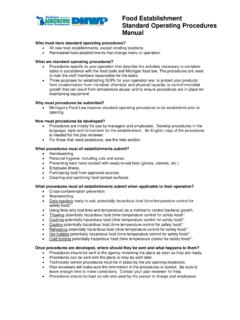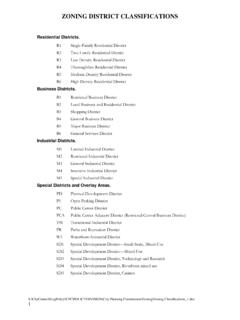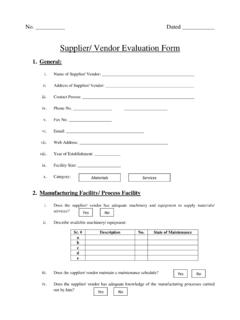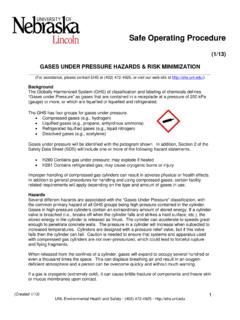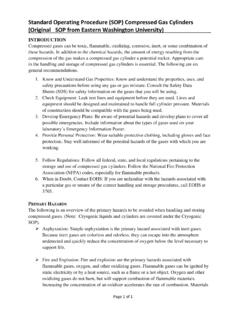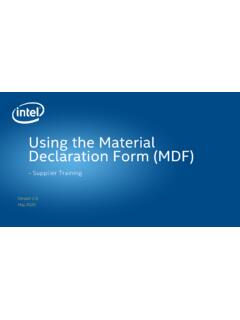Transcription of Food Establishment Standard Operating Procedures Manual
1 Who must have Standard Operating Procedures ? All new food establishments, except vending locations. Remodeled food establishments that change menu or operation. What are Standard Operating Procedures ? Procedures specific to your operation that describe the activities necessary to complete tasks in accordance with the food code and Michigan food law. The Procedures are used to train the staff members responsible for the tasks. Three purposes for establishing SOPs for your operation are: to protect your products from contamination from microbial, chemical, and physical hazards; to control microbial growth that can result from temperature abuse; and to ensure Procedures are in place for maintaining equipment. Why must Procedures be submitted? Michigan's Food Law requires Standard Operating Procedures to be established prior to opening. How must Procedures be developed? Procedures are mostly for use by managers and employees. Develop Procedures in the language, style and format best for the Establishment .
2 An English copy of the Procedures is needed for the plan reviewer. For those that need assistance, see the help section. What Procedures must all establishments submit? Handwashing. Personal hygiene, including cuts and sores. Preventing bare hand contact with ready-to-eat food (gloves, utensils, etc.). Employee illness. Purchasing food from approved sources. Cleaning and sanitizing food contact surfaces. What Procedures must all establishments submit when applicable to their operation? Cross-contamination prevention. Warewashing. Date-marking ready-to-eat, potentially hazardous food (time/temperature control for safety food)*. Using time only (not time and temperature) as a method to control bacterial growth. Thawing potentially hazardous food (time temperature control for safety food)*. Cooking potentially hazardous food (time temperature control for safety food)*. Cooling potentially hazardous food (time temperature control for safety food)*.
3 Reheating potentially hazardous food (time temperature control for safety food)*. Hot holding potentially hazardous food (time temperature control for safety food)*. Cold holding potentially hazardous food (time temperature control for safety food)*. Once Procedures are developed, where should they be sent and what happens to them? Procedures should be sent to the agency reviewing the plans as soon as they are ready. Procedures can be sent with the plans or may be sent later. Technically correct Procedures must be in place by the pre-opening inspection. Plan reviewers will make sure the information in the Procedures is correct. Be sure to leave enough time to make corrections. Contact your plan reviewer for help. Procedures should be kept on-site and used by the person in charge and employees. Food Establishment Standard Operating Procedures Manual Standard Operating Procedure (SOP) Writing Help For establishments that need help in writing a Standard Operating procedure, this section contains: Blank forms in a suggested format.
4 Sample handwashing SOP. Suggested questions to answer, technical help and Michigan Modified FDA 2009 Food Code references for each required SOP. Make copies as needed Standard Operating Procedure Establishment Name: _____ Subject: _____ What will be done and who will do it? Who will make sure it's done and how? How should problems be fixed? What records will be kept? Created (Date): By: Last Revised: By: Standard Operating Procedure Joe's Coney Dogs SAMPLE Subject: Handwashing What will be done and who will do it? New employees must: Review this procedure. Watch the video "Effective Handwashing." Be trained by the team leader. Sign off on the new employee training checklist. All employees must wash hands at labeled handsinks (2 in kitchen). DO NOT wash at dishwashing, food or mop sinks. Handwashing steps are as follows: Use water as hot as you can stand. Soap hands and lower forearms. Scrub for 20 seconds.
5 Rinse. Dry with paper towel. Avoid recontamination of hands by using paper towel or other barrier to turn off faucet handles. When must all employees wash hands? At beginning of shift. After using toilet. After coughing, sneezing, using tissue or handkerchief, eating, drinking or using tobacco. Between touching raw food and ready-to-eat food. Between glove changes. After handling dirty dishes. After touching hair or any body part except clean hands and arms. During food preparation as often as necessary to prevent cross-contamination. After doing other activities that contaminate the hands, such as handling trash or chemicals. Who will make sure it's done and how? Team leaders are expected to continually model appropriate handwashing practices for employees. Team leaders shall monitor employee handwashing. Dishwashing staff must assure that handwashing stations, including bathrooms, are supplied with soap and paper towels. Team leaders shall monitor handsinks at least once per shift to assure that sinks have the necessary supplies.
6 The day team leader shall assure that necessary supplies are in stock. How should problems be fixed? Team leaders must immediately train and counsel employees who improperly or inadequately wash hands or don't keep handsinks supplied. Team leaders must notify owner of any handwashing problems that can't be solved through training and counseling. What records will be kept? Complete new employee training checksheet. Created (Date): 6/15/13 By: Joe Dawton, Owner Last Revised: By: For each Standard Operating procedure that may be required, questions to answer and technical information are listed. Handwashing Questions to answer What training will employees receive? What training will supervisors receive? What is the correct way to wash? When should employees wash? Where should employees wash or not wash? Who will keep sinks supplied with soap and paper towel? Technical Help (See Food Code ; ; ) All handsinks in bathrooms and kitchens must be labeled with a sign.
7 Washing hands at dishwashing, mop or food sinks is not allowed. Handwashing steps are: o use water as hot as you can stand o soap hands and lower forearms, o scrub for 20 seconds, o rinse o dry with paper towel or hot air dryer o use paper towel or other barrier to turn off faucet handles. Hand sanitizers can be used after washing hands. Hand sanitizers may not be used to replace washing hands. All employees must wash hands: o at beginning of shift, o after using toilet, o after coughing, sneezing, using tissue, eating, drinking or using tobacco, o between touching raw food and ready-to-eat food, o between glove changes, o after handling dirty dishes, o after touching hair or any body part except clean hands and arms, o during food preparation as often as necessary to prevent cross-contamination, or o after doing other activities that contaminate the hands, such as handling trash or chemicals. Personal hygiene Questions to answer What personal hygiene steps are needed before an employee comes to work?
8 What clothes or uniforms must employees wear to work? What must an employee do if they have a cut or sore on their hands, arms or face? Where can employees drink, smoke or eat? What employee training will be done? Technical Help (See Food Code subparts (A) (1) (e); ; ; ; 2-401) Outer clothing of food employees must be clean. Any cuts, burns, boils, skin infections or infected wounds on a food handler should be covered with a bandage. Cover bandages on hands with gloves. Food handlers with bandages may need to be assigned to jobs that do not involve food contact. Eating, drinking or using tobacco can only be done in certain areas away from food or equipment. Employees may drink in the food preparation area if the drink has a cover that does not have to be touched (a cover and a straw often work well). Preventing bare hand contact with ready-to-eat food Questions to answer What ready-to-eat foods are served? How will hand contact with ready-to-eat foods be avoided?
9 For each food, should an employee use utensils, deli tissue, spatulas, tongs, single-use gloves, or dispensing equipment? Are different types of single-use gloves needed for employees that do different jobs? Are only vinyl gloves being used to eliminate allergic reactions from latex gloves? Is avoiding bare hand contact with some foods not feasible? If you answered yes, will ready-to-eat food be touched with bare hands under a written policy that complies with the Michigan Modified FDA 2009 Food Code? Approval from the regulatory authority is required. What employee training will be done? Technical Help (See Food Code and ) Ready-to-eat foods are foods that are edible without washing, cooking or additional preparation. This includes raw animal foods that have been cooked; raw fruit and vegetables that have been washed, rinds, peels, husks or shells removed, and/or cooked for hot holding; all potentially hazardous food (time/temperature control for safety food)* that have been cooked and cooled; and baked goods.
10 Food handlers may not touch ready-to-eat foods with their bare hands. Food employees can touch raw fruits and vegetables to wash them before they are cut. Some ways to avoid touching ready-to-eat food include using utensils, deli tissue, spatulas, tongs, single-use gloves, or dispensing equipment. Suppliers make many different types of gloves. Some are loose and some are tight fitting. Some have powder and some are powder-free. Some employees may have or may develop allergies to latex gloves. Consult your glove supplier for assistance. Avoiding the handling of some ready-to-eat foods may not be possible. When food employees must touch ready-to-eat food, the Establishment must first have approval from the regulatory authority along with written Procedures , a written employee health policy, documented employee training, documented handwashing and two or more control measures that meets Michigan Modified FDA 2009 Food Code section (D). Employee Illness Questions to answer What personal health information should be asked of applicants?
